Can the Building Make a Difference to User’s Health in Indoor Environments? The Influence of PM2.5 Vertical Distribution on the IAQ of a Student House over Two Periods in Milan in 2024
Abstract
1. Introduction
1.1. Literature Review Content and Previous Research on PM Vertical Distribution
1.2. The Aim of This Research
2. Methods
2.1. The Student House as the Fieldwork Site
2.2. Monitoring Devices, Measurement Parameters, and Calibration
2.3. The 2 Monitoring Periods and Monitoring Spot Selection
2.4. Device Deployment and Data Collection Workflow
2.5. Survey on the Internal Occupancy Condition
2.6. The Reference Levels of the Environmental Parameters and Involved Air Pollutants
3. Results from Monitoring Devices and Questionnaires
3.1. The General Results of Indoor and Outdoor Data from the Two Periods
3.1.1. Environmental Parameters and Weather Conditions
3.1.2. CO2 Variations in the Two Periods
3.1.3. PM Levels in the Two Periods
3.2. Results from the Questionnaires
3.2.1. Users’ Basic Information
3.2.2. User’s Perception and Reported Symptoms
3.2.3. The Reported Symptoms from the Two Periods
4. Discussion
4.1. The PM2.5 Vertical Distribution and Its I/O Ratio
4.1.1. The PM2.5 Vertical Distribution
4.1.2. Indoor PM2.5 Level and Lower I/O Ratio at the Higher Floor
4.2. PM2.5 I/O Ratio with Occupancy and Ventilation
4.3. The I/O Ratio of PM2.5 and the RH Changes from Weather Conditions
4.4. Indoor/Outdoor AP Differences and PM2.5
4.5. Daily Features of PM2.5 I/O Ratio
4.6. The Reported Symptoms and IAQ from the Survey and Suggestions to Residents
4.6.1. The Bedrooms with Symptom Reports in Period-2
4.6.2. The Kitchens with Symptom Reports in Period-2
4.6.3. Suggestions Based on IAQ Conditions Observed
Night Ventilation Before Sleep
Cooking Emission Accumulation in Other Rooms
5. Conclusions and Limitations
5.1. Final Considerations
5.2. Limitations and Future Developments
Supplementary Materials
Author Contributions
Funding
Institutional Review Board Statement
Informed Consent Statement
Data Availability Statement
Acknowledgments
Conflicts of Interest
Abbreviations
| ABL | Atmosphere Boundary Layer |
| AP | Air Pressure |
| CAMS | Copernicus Atmosphere Monitoring Service |
| CCN | Cloud Condensation Nuclei |
| CO2 | Carbon Dioxide |
| HF | Haze and Fog |
| IAQ | Indoor Air Quality |
| IL | Inversion Layer |
| I/O | Indoor and Outdoor |
| PM10 | Particulate Matter 10 μm or less |
| PM2.5 | Particulate Matter 2.5 μm or less |
| RH | Relative Humidity |
| SL | Surface Layer |
| T | Temperature |
| UAV | Unmanned Aerial Vehicle |
References
- Morganti, A.; Brambilla, A.; Aguglia, A.; Amerio, A.; Miletto, N.; Parodi, N.; Porcelli, C.; Odone, A.; Costanza, A.; Signorelli, C.; et al. Effect of Housing Quality on the Mental Health of University Students during the COVID-19 Lockdown. Int. J. Environ. Res. Public Health 2022, 19, 2918. [Google Scholar] [CrossRef]
- Leech, J.A.; Nelson, W.C.; Burnett, R.T.; Aaron, S.; Raizenne, M.E. It’s about time: A comparison of Canadian and American time-activity patterns. J. Expos. Anal. Environ. Epidemiol. 2002, 12, 427–432. [Google Scholar] [CrossRef]
- Brasche, S.; Bischof, W. Daily time spent indoors in German homes—Baseline data for the assessment of indoor exposure of German occupants. Int. J. Hyg. Environ. Health 2005, 208, 247–253. [Google Scholar] [CrossRef]
- Klepeis, N.E.; Nelson, W.C.; Ott, W.R.; Robinson, J.P.; Tsang, A.M.; Switzer, P.; Behar, J.V.; Hern, S.C.; Engelmann, W.H. The National Human Activity Pattern Survey (NHAPS): A resource for assessing exposure to environmental pollutants. J. Expos. Anal. Environ. Epidemiol. 2001, 11, 231–252. [Google Scholar] [CrossRef]
- Lopez, N. Copernicus: Saharan Dust Strongly Affects Air Quality in Eastern Mediterranean. Available online: https://atmosphere.copernicus.eu/copernicus-saharan-dust-strongly-affects-air-quality-eastern-mediterranean (accessed on 3 March 2025).
- Babaan, J.B.; Ballori, J.P.; Tamondong, A.M.; Ramos, R.V.; Ostrea, P.M. Estimation of PM 2.5 vertical distribution using customized UAV and mobile sensors in Brgy. UP Campus, Diliman, Quezon City. In Proceedings of the 2018 International Conference on Geomatic and Geospatial Technology: Geospatial and Disaster Risk Management, GGT 2018, Kuala Lumpur, Malaysia, 3–5 September 2018; pp. 89–103. [Google Scholar] [CrossRef]
- Choomanee, P.; Bualert, S.; Thongyen, T.; Salao, S.; Szymanski, W.W.; Rungratanaubon, T. Vertical variation of carbonaceous aerosols within the PM2.5 fraction in Bangkok, Thailand. Aerosol Air Qual. Res. 2020, 20, 43–52. [Google Scholar] [CrossRef]
- Han, S.; Zhang, Y.; Wu, J.; Zhang, X.; Tian, Y.; Wang, Y.; Ding, J.; Yan, W.; Bi, X.; Shi, G.; et al. Evaluation of regional background particulate matter concentration based on vertical distribution characteristics. Atmos. Chem. Phys. 2015, 15, 11165–11177. [Google Scholar] [CrossRef]
- Han, S.Q.; Hao, T.Y.; Zhang, M.; Yao, Q.; Liu, J.L.; Cai, Z.Y.; Li, X.J. Observation Analysis on Microphysics Characteristics of Long-lasting Severe Fog and Haze Episode at Urban Canopy Top. Aerosol Air Qual. Res. 2018, 18, 2475–2486. [Google Scholar] [CrossRef]
- Lu, S.J.; Wang, D.S.; Wang, Z.Y.; Li, B.; Peng, Z.R.; Li, X.B.; Gao, Y. Investigating the Role of Meteorological Factors in the Vertical Variation in PM2.5 by Unmanned Aerial Vehicle Measurement. Aerosol Air Qual. Res. 2019, 19, 1493–1507. [Google Scholar] [CrossRef]
- Samad, A.; Vogt, U.; Panta, A.; Uprety, D. Vertical distribution of particulate matter, black carbon and ultra-fine particles in Stuttgart, Germany. Atmos. Pollut. Res. 2020, 11, 1441–1450. [Google Scholar] [CrossRef]
- Piironen, A. Atmospheric Boundary Layer Structure. Available online: http://lidar.ssec.wisc.edu/papers/akp_thes/node6.htm (accessed on 13 May 2022).
- Huang, X.; Huang, J.; Ren, C.; Wang, J.; Wang, H.; Wang, J.; Yu, H.; Chen, J.; Gao, J.; Ding, A. Chemical Boundary Layer and Its Impact on Air Pollution in Northern China. Environ. Sci. Technol. Lett. 2020, 7, 826–832. [Google Scholar] [CrossRef]
- Miao, C.; Yu, S.; Zhang, Y.; Hu, Y.; He, X.; Chen, W. Assessing outdoor air quality vertically in an urban street canyon and its response to microclimatic factors. J. Environ. Sci. 2023, 124, 923–932. [Google Scholar] [CrossRef]
- Cichowicz, R.; Dobrzański, M. Indoor and Outdoor Concentrations of Particulate Matter and Gaseous Pollutants on Different Floors of a University Building: A Case Study. J. Ecol. Eng. 2020, 22, 162–173. [Google Scholar] [CrossRef]
- Cichowicz, R.; Dobrzanski, M. 3D spatial analysis of particulate matter (PM10, PM2.5 and PM1.0) and gaseous pollutants (H2S, SO2 and VOC) in urban areas surrounding a large heat and power plant. Energies 2021, 14, 4070. [Google Scholar] [CrossRef]
- Castaldo, G.; Gambaro, M.; Mussinelli, E.; Tartaglia, A. The Quality of the Project and the MIUR Standards for the Control and Funding of Buildings for Education and Training. In Buildings for Education: A Multidisciplinary Overview of the Design of School Buildings; Della Torre, S., Bocciarelli, M., Daglio, L., Neri, R., Eds.; Springer International Publishing: Cham, Switzerland, 2020; pp. 117–125. [Google Scholar] [CrossRef]
- Baiardi, L.; Ciaramella, A.; Bellintani, S. A Development and Management Model for “Smart” Temporary Residences. In Regeneration of the Built Environment from a Circular Economy Perspective; Della Torre, S., Cattaneo, S., Lenzi, C., Zanelli, A., Eds.; Springer International Publishing: Cham, Switzerland, 2020; pp. 337–346. [Google Scholar] [CrossRef]
- Comune di Milano. Calendario di Accensione Degli Impianti di Riscaldamento. Available online: https://www.comune.milano.it/aree-tematiche/ambiente/energia/calendario-accensione-impianti (accessed on 20 May 2025).
- Yu, Y.; Gola, M.; Settimo, G.; Buffoli, M.; Capolongo, S. Feasibility and Affordability of Low-Cost Air Sensors with Internet of Things for Indoor Air Quality Monitoring in Residential Buildings: Systematic Review on Sensor Information and Residential Applications, with Experience-Based Discussions. Atmosphere 2024, 15, 1170. [Google Scholar] [CrossRef]
- Sensirion. SCD4x. 2023. Available online: https://sensirion.com/media/documents/48C4B7FB/64C134E7/Sensirion_SCD4x_Datasheet.pdf (accessed on 28 August 2024).
- BOSCH. BME680-Datasheet. 2024. Available online: https://www.bosch-sensortec.com/media/boschsensortec/downloads/datasheets/bst-bme680-ds001.pdf (accessed on 30 April 2024).
- Yong, Z. Digital Universal Particle Concentration Sensor PMS5003 Series Data Manual. 2016. Available online: https://www.aqmd.gov/docs/default-source/aq-spec/resources-page/plantower-pms5003-manual_v2-3.pdf?sfvrsn=2 (accessed on 28 August 2024).
- Levra Levron, A.; Marino, D.; Pollo, R. Refurbishment of Social housing: A survey of the building stock owned by ATC Torino. TECHNE J. Technol. Archit. Environ. 2016, 12, 199–206. [Google Scholar] [CrossRef]
- Laghezza, A.; Yu, Y.; Settimo, G.; Capolongo, S.; Gola, M. How to evaluate the indoor air quality through users’ perception and low-cost sensors: A methodology for defining how to match the qualitative and quantitative analysis in indoor working spaces, as a strategy for promoting health. In Proceedings of the INDOOR AIR 2024-Conference Program and Proceedings, Honolulu, HI, USA, 7–11 July 2024. [Google Scholar]
- Riva, A.; Rebecchi, A.; Capolongo, S.; Gola, M. Can Homes Affect Well-Being? A Scoping Review among Housing Conditions, Indoor Environmental Quality, and Mental Health Outcomes. Int. J. Environ. Res. Public Health 2022, 19, 15975. [Google Scholar] [CrossRef]
- ANSI/ASHRAE Standard 55-2023; Thermal Environmental Conditions for Human Occupancy. American Society of Heating Refrigerating and Air-Conditioning Engineers (ASHRAE): Peachtree Corners, GA, USA; American National Standards Institute (ANSI): Washington, DC, USA, 2023. Available online: https://www.ashrae.org/technical-resources/bookstore/standard-55-thermal-environmental-conditions-for-human-occupancy (accessed on 30 June 2024).
- American Society of Heating Refrigerating and Air-Conditioning Engineers (ASHRAE). 2016 Ashrae Handbook—HVAC Systems and Equipment. Humidifiers 2016; ASHRAE: Peachtree Corners, GA, USA, 2016; Available online: https://www.ashrae.org/advertising/handbook-advertising/systems (accessed on 15 September 2023).
- Settimo, G.; Yu, Y.; Gola, M.; Buffoli, M.; Capolongo, S. Challenges in IAQ for Indoor Spaces: A Comparison of the Reference Guideline Values of Indoor Air Pollutants from the Governments and International Institutions. Atmosphere 2023, 14, 633. [Google Scholar] [CrossRef]
- World Health Organization (WHO) Regional Office for Europe. Air Quality Guidelines for Europe, 2nd ed.; World Health Organization Regional Office for Europe: Copenhagen, Denmark, 2000. [Google Scholar]
- Umwelt Bundesamt (UB). Zur Gesundheitlichen Bewertung der Innenraumluft setzt der AIR Richtwerte, Hygienische Leitwerte Sowie Risikobezogene Leitwerte Fest. Available online: https://www.umweltbundesamt.de/themen/gesundheit/kommissionen-arbeitsgruppen/ausschuss-fuer-innenraumrichtwerte#ausschuss-fur-innenraumrichtwerte-air (accessed on 23 February 2023).
- Government of the United Kingdom (HM Goverment). The Building Regulations 2010 Materials and Workmanship Approved Document 7 (July 2021 Edition). 2021. Available online: https://assets.publishing.service.gov.uk/media/6717d29438149ce9d09e3862/The_Merged_Approved_Documents_Oct24.pdf (accessed on 20 May 2023).
- Public Health England. Indoor Air Quality Guidelines for Selected Volatile Organic Compounds (VOCs) in the UK. 2019. Available online: https://assets.publishing.service.gov.uk/government/uploads/system/uploads/attachment_data/file/831319/VO__statement_Final_12092019_CS__1_.pdf (accessed on 15 September 2022).
- Education & Skills Funding Agency. Building Bulletin 101. Guidelines on Ventilation, Thermal Comfort and Indoor Air Quality in Schools: Government Response to Public Consultation. 2018. Available online: https://assets.publishing.service.gov.uk/government/uploads/system/uploads/attachment_data/file/735652/BB101_Consultation_response.pdf (accessed on 15 September 2022).
- Ministry of Labour and Social Inclusion. Regulations Concerning the Design and Layout of Workplaces and Work Premises (the Workplace Regulations). 2013. Available online: https://lovdata.no/dokument/SFE/forskrift/2011-12-06-1356 (accessed on 15 September 2022).
- Minister of Health and Social Welfare. Ordinance of the Minister of Health and Social Welfare of March 12, 1996 on Acceptable Concentrations and Intensity of Adverse to Health Agents, Secreted by Construction Materials, Equipment and Fittings in Rooms Designed to Accommodate People. Polish Monitor No. 19 of 1996. Item. 23 1996. Available online: https://www.ilo.org/dyn/natlex/natlex4.detail?p_lang=en&p_isn=99664 (accessed on 10 September 2022).
- French Agency for Food Environmental and Occupational Health & Safety (ANSES). Indoor Air Quality Guidelines (IAQGs). Available online: https://www.anses.fr/en/content/indoor-air-quality-guidelines-iaqgs (accessed on 28 April 2022).
- Légifrance. LOI n° 2010-788 du 12 Juillet 2010 Portant Engagement National Pour L’environnement. 2010. Available online: https://www.legifrance.gouv.fr/jorf/id/JORFTEXT000022470434 (accessed on 15 June 2022).
- Légifrance. Décret n° 2011-1727 du 2 Décembre 2011 Relatif Aux Valeurs-Guides Pour L’air Intérieur Pour le Formaldéhyde et le Benzène. 2011. Available online: https://www.legifrance.gouv.fr/eli/decret/2011/12/2/DEVP1116199D/jo/texte (accessed on 16 June 2022).
- Légifrance. Décret n° 2015-1000 du 17 Août 2015 Relatif aux Modalités de Surveillance de la Qualité de L’air Intérieur Dans Certains Établissements Recevant du Public. 2015. Available online: https://www.legifrance.gouv.fr/eli/decret/2015/8/17/DEVP1406204D/jo/texte (accessed on 15 June 2022).
- Légifrance. Décret n° 2015-1926 du 30 Décembre 2015 Modifiant le Décret n° 2012-14 du 5 Janvier 2012 Relatif À L’évaluation des Moyens D’aération et À la Mesure des Polluants Effectuées au Titre de la Surveillance de la Qualité de L’air Intérieur de Certains Établissements Recevant du Public. 2015. Available online: https://www.legifrance.gouv.fr/loda/id/JORFTEXT000031741934 (accessed on 15 June 2022).
- Légifrance. Arrêté du 1er Juin 2016 Relatif aux Modalités de Surveillance de la Qualité de L’air Intérieur Dans Certains Établissements Recevant du Public. 2016. Available online: https://www.legifrance.gouv.fr/loda/id/JORFTEXT000032630331 (accessed on 15 June 2022).
- Légifrance. Décret n° 2022-1689 du 27 Décembre 2022 Modifiant le Code de L’environnement en Matière de Surveillance de la Qualité de L’air Intérieur. 2022. Available online: https://www.legifrance.gouv.fr/jorf/id/JORFTEXT000046829320 (accessed on 20 January 2023).
- Légifrance. Décret n° 2022-1690 du 27 Décembre 2022 Modifiant le Décret n° 2012-14 du 5 Janvier 2012 Relatif à L’évaluation des Moyens D’aération et À la Mesure des Polluants Effectuées au Titre de la Surveillance de la Qualité de L’air Intérieur de Certains Établissements Recevant du Public. 2022. Available online: https://www.legifrance.gouv.fr/jorf/id/JORFTEXT000046829352 (accessed on 20 January 2023).
- Légifrance. Arrêté du 27 Décembre 2022 Modifiant L’arrêté du 1er Juin 2016 Relatif aux Modalités de Surveillance de la Qualité de L’air Intérieur dans Certains Établissements Recevant du Public. 2022. Available online: https://www.legifrance.gouv.fr/jorf/id/JORFTEXT000046829603 (accessed on 20 January 2023).
- Health Council of the Netherlands. Indoor Air Quality in Primary Schools: And the Value of Carbon Dioxide as An Indicator of Air Quality. 2010. Available online: https://www.healthcouncil.nl/documents/advisory-reports/2010/04/29/indoor-air-quality-in-primary-schools. (accessed on 24 September 2022).
- Commonwealth of Australia and States and Territories of Australia (CASTA). Indoor Air Quality. 2021. Available online: https://www.abcb.gov.au/sites/default/files/resources/2021/Handbook-Indoor-Air-Quality.pdf (accessed on 20 June 2022).
- Mentese, S.; Rad, A.Y.; Arisoy, M.; Güllü, G. Multiple comparisons of organic, microbial, and fine particulate pollutants in typical indoor environments: Diurnal and seasonal variations. J. Air Waste Manag. Assoc. 2012, 62, 1380–1393. [Google Scholar] [CrossRef]
- Vardoulakis, S.; Giagloglou, E.; Steinle, S.; Davis, A.; Sleeuwenhoek, A.; Galea, K.S.; Dixon, K.; Crawford, J.O. Indoor exposure to selected air pollutants in the home environment: A systematic review. Int. J. Environ. Res. Public Health 2020, 17, 8972. [Google Scholar] [CrossRef]
- Levin, Z.; Cotton, W.R. Aerosol Pollution Impact on Precipitation: A Scientific Review; Springer: Dordrecht, The Netherlands, 2009; pp. 1–386. [Google Scholar] [CrossRef]
- Twomey, S. Pollution and the planetary albedo. Atmos. Environ. Part A Gen. Top. 1974, 8, 1251–1256. [Google Scholar] [CrossRef]
- Stull, R.B. An Introduction to Boundary Layer Meteorology; Springer: Dordrecht, The Netherlands, 1988. [Google Scholar]
- Bakas, N.A.; Fotiadi, A.; Kariofillidi, S. Climatology of the boundary layer height and of the wind field over Greece. Atmosphere 2020, 11, 910. [Google Scholar] [CrossRef]
- Miller, S.L.; Facciola, N.A.; Toohey, D.; Zhai, J. Ultrafine and fine particulate matter inside and outside of mechanically ventilated buildings. Int. J. Environ. Res. Public Health 2017, 14, 128. [Google Scholar] [CrossRef] [PubMed]
- Zhang, J.; Zhou, Z.; Wang, C.; Xue, K.; Liu, Y.; Fang, M.; Zuo, J.; Sheng, Y. Research on the Influence of Indoor Relative Humidity on PM2.5 Concentration in Residential Buildings. In Proceedings of the 5th Annual International Workshop on Materials Science and Engineering, IWMSE 2019, Changsha, China, 17–18 May 2019. [Google Scholar] [CrossRef]
- Hinds, W.C.; Zhu, Y. Aerosol Technology: Properties, Behavior, and Measurement of Airborne Particles, 3rd ed.; Wiley: Hoboken, NJ, USA, 2022; p. 425. [Google Scholar]
- World Health Organization (WHO). WHO Global air Quality Guidelines: Particulate Matter (PM2.5 and PM10), Ozone, Nitrogen Dioxide, Sulfur Dioxide and Carbon Monoxide; World Health Organization: Geneva, Switzerland, 2021. [Google Scholar]
- Hart, R.; Liang, L.; Dong, P. Monitoring, mapping, and modeling spatial–temporal patterns of PM2.5 for improved understanding of air pollution dynamics using portable sensing technologies. Int. J. Environ. Res. Public Health 2020, 17, 4914. [Google Scholar] [CrossRef] [PubMed]
- Gola, M.; Settimo, G.; Capolongo, S. No Impacts on Users’ Health: How Indoor Air Quality Assessments Can Promote Health and Prevent Disease. In Internet of Things; Springer Science and Business Media Deutschland GmbH: Berlin/Heidelberg, Germany, 2022; pp. 43–54. [Google Scholar] [CrossRef]
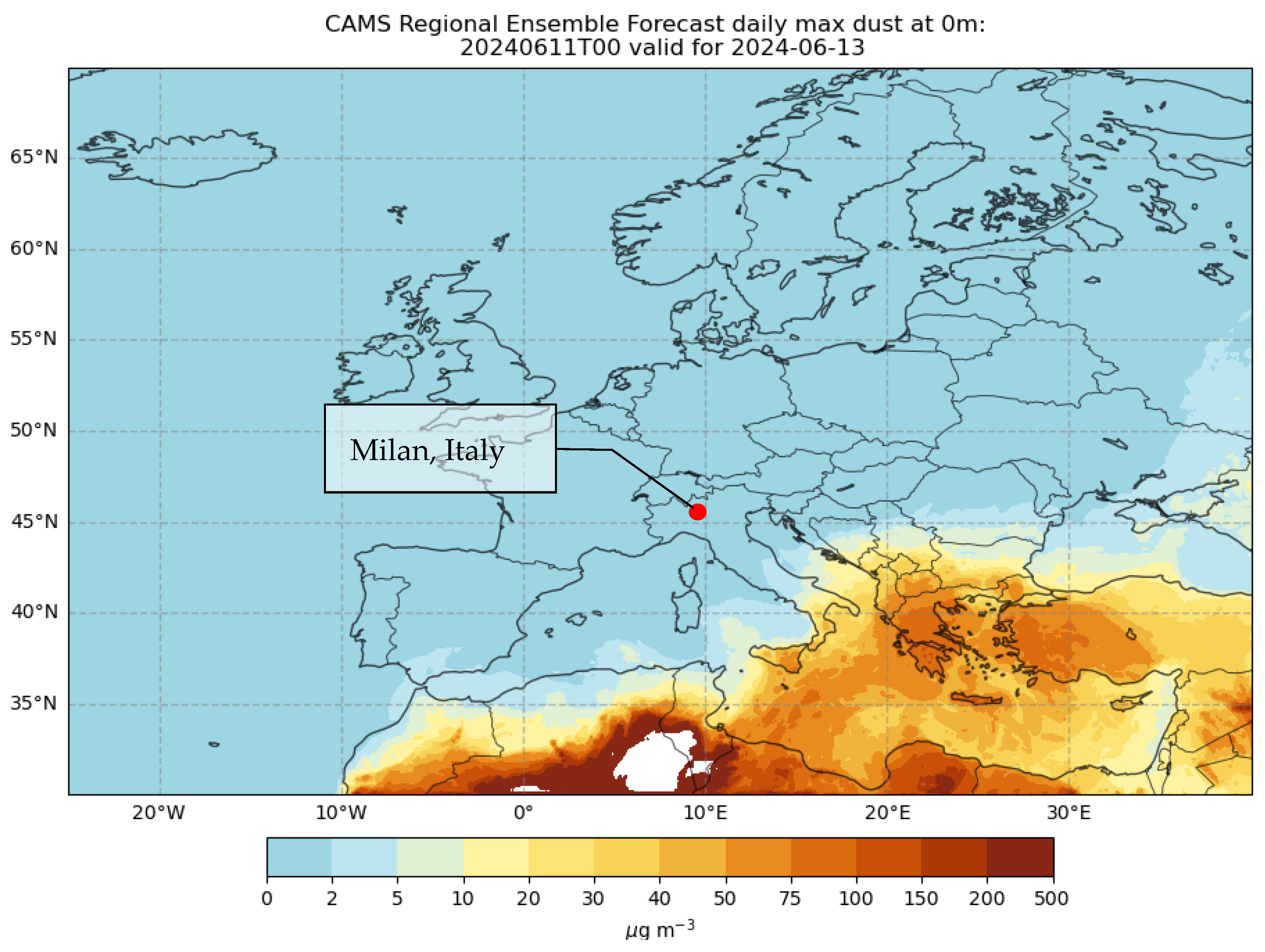
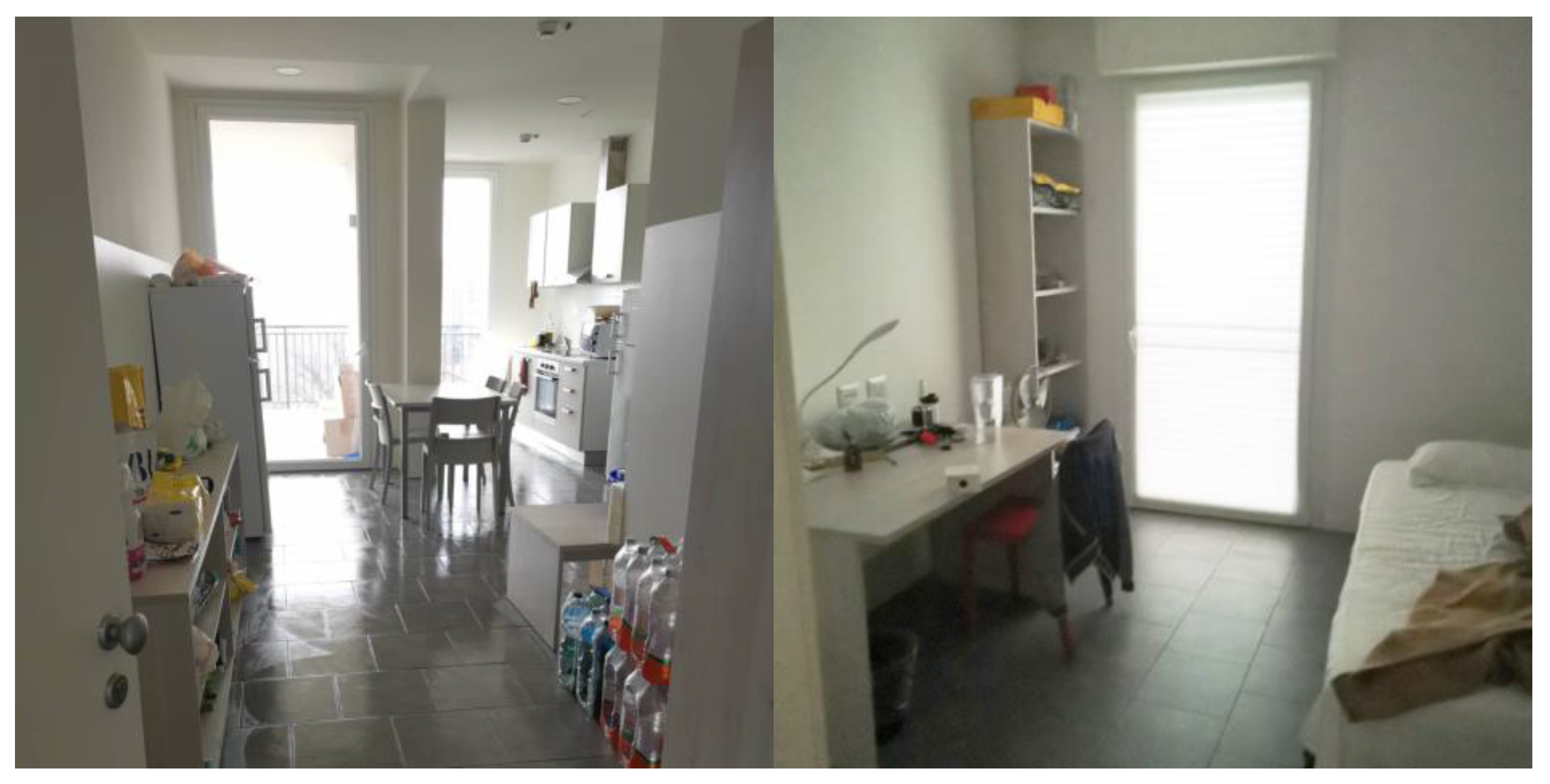
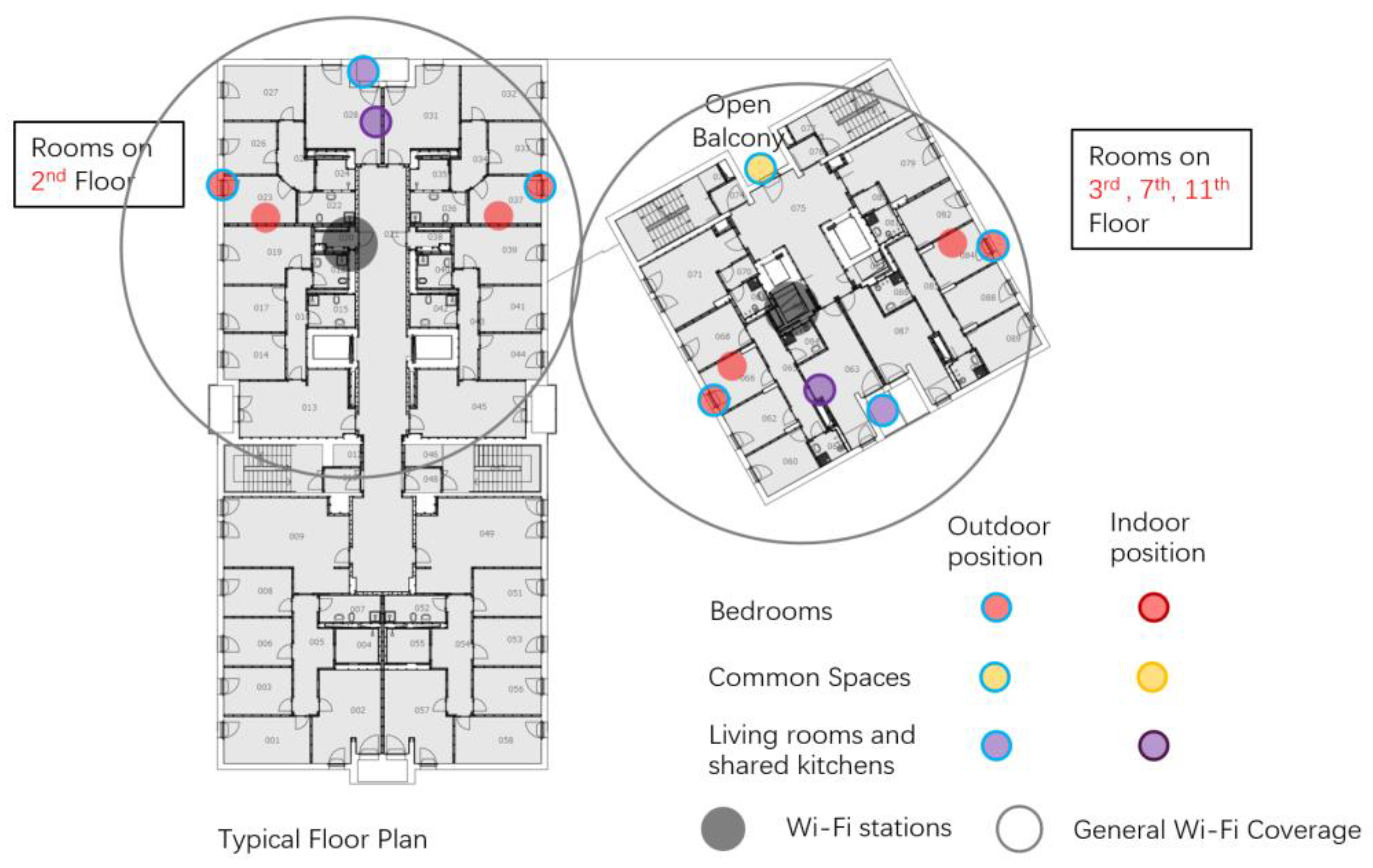
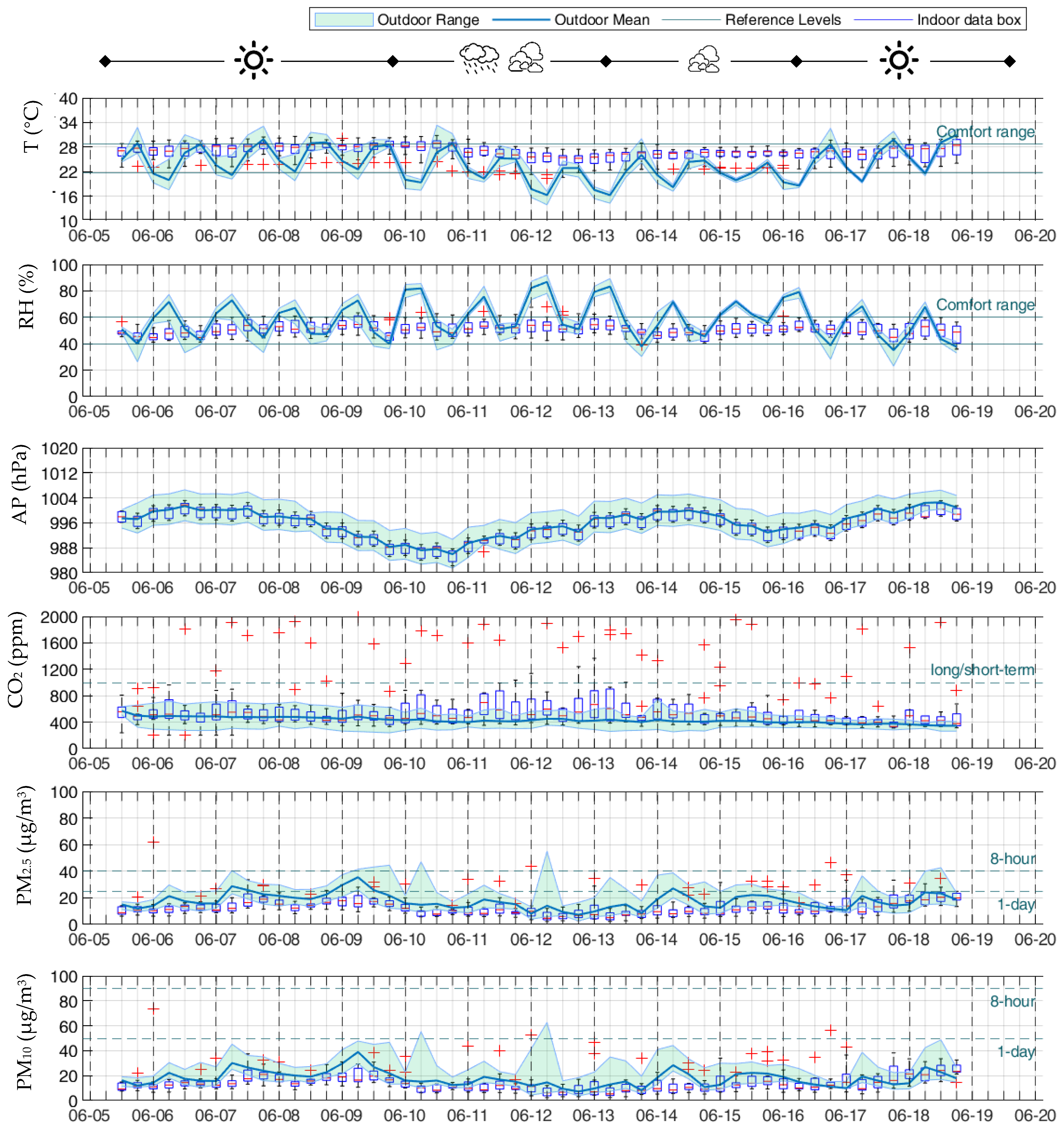





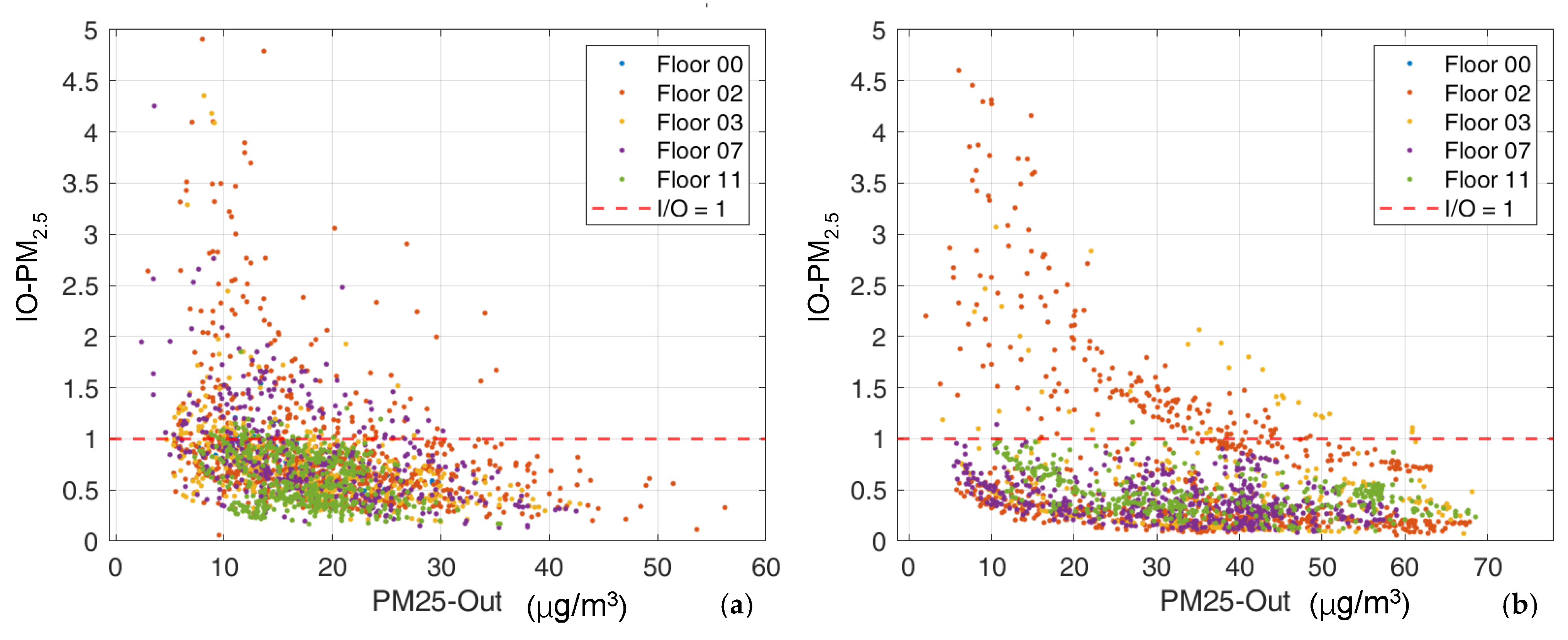

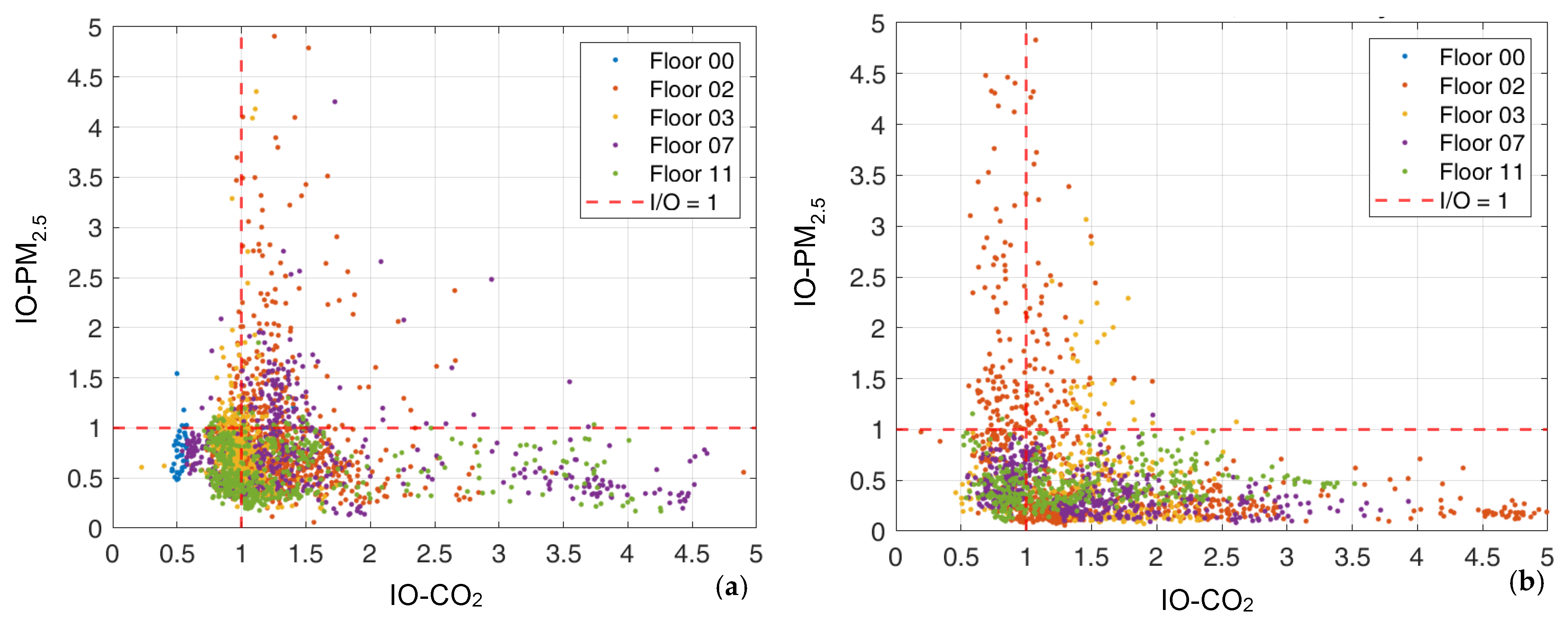
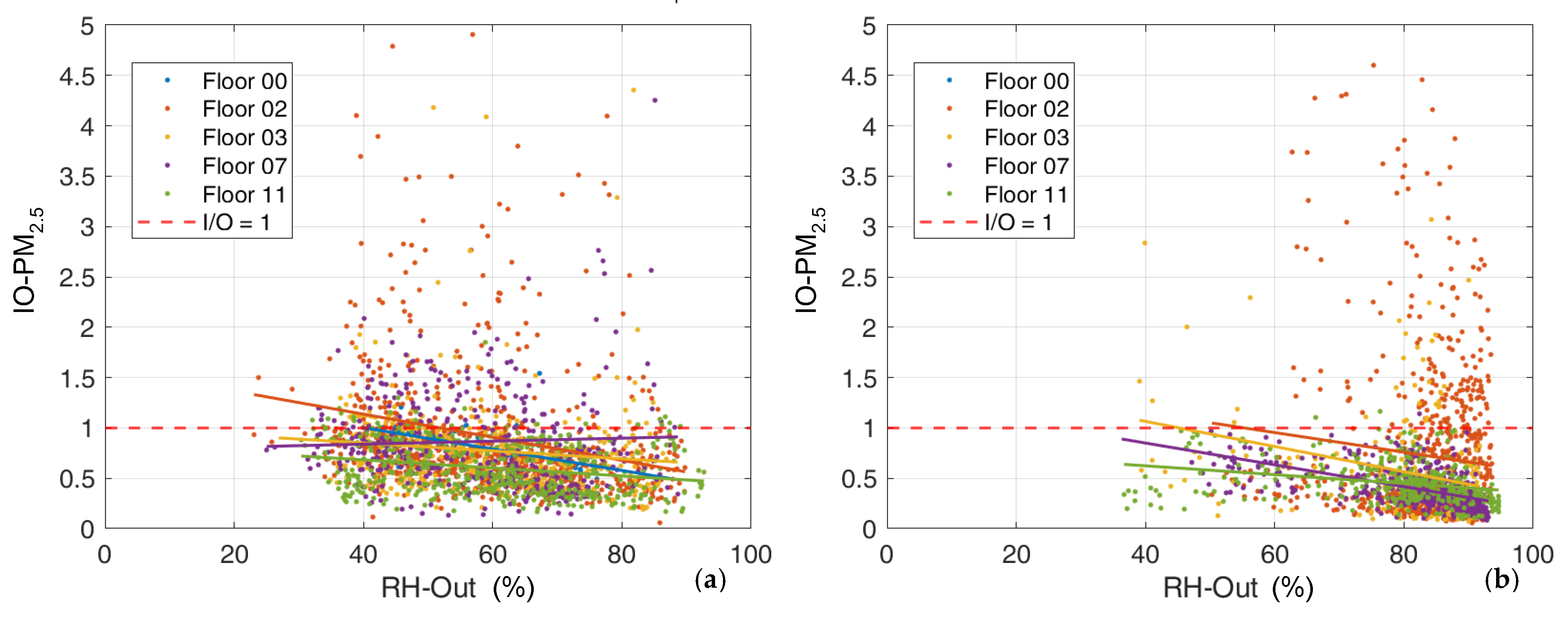

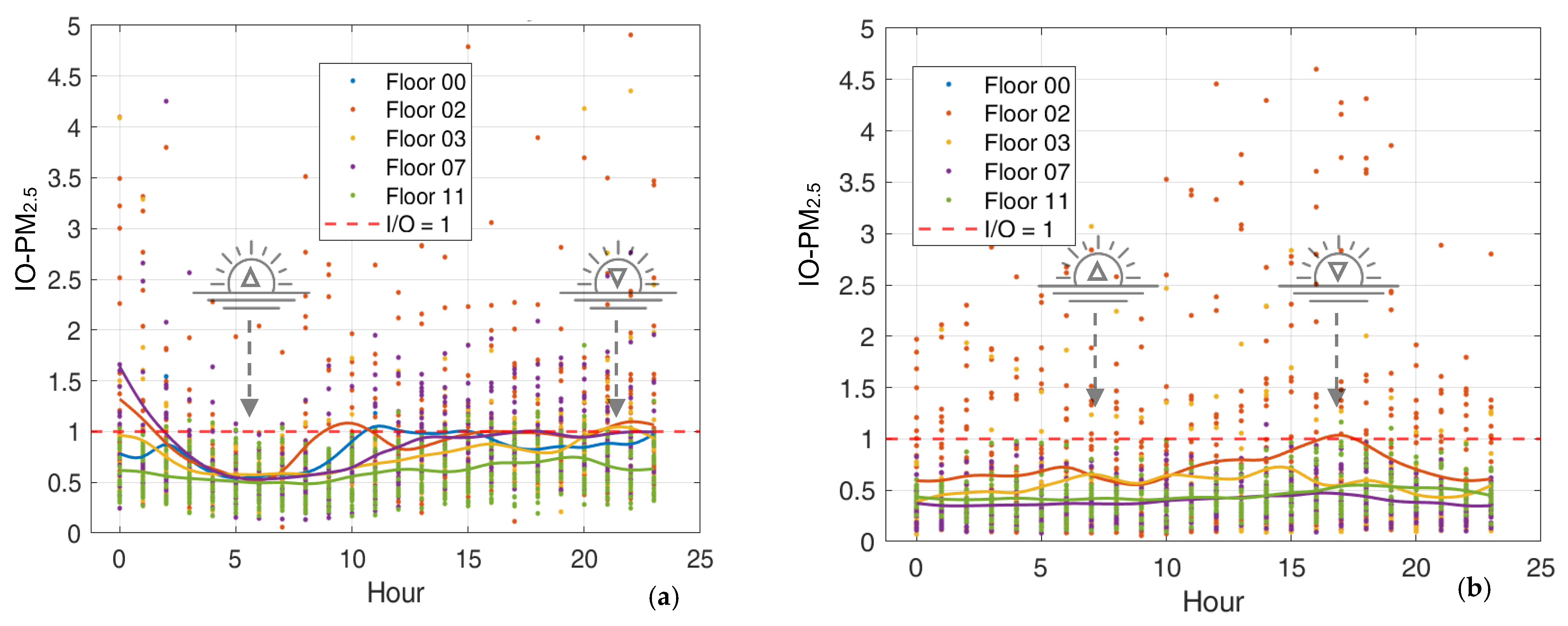

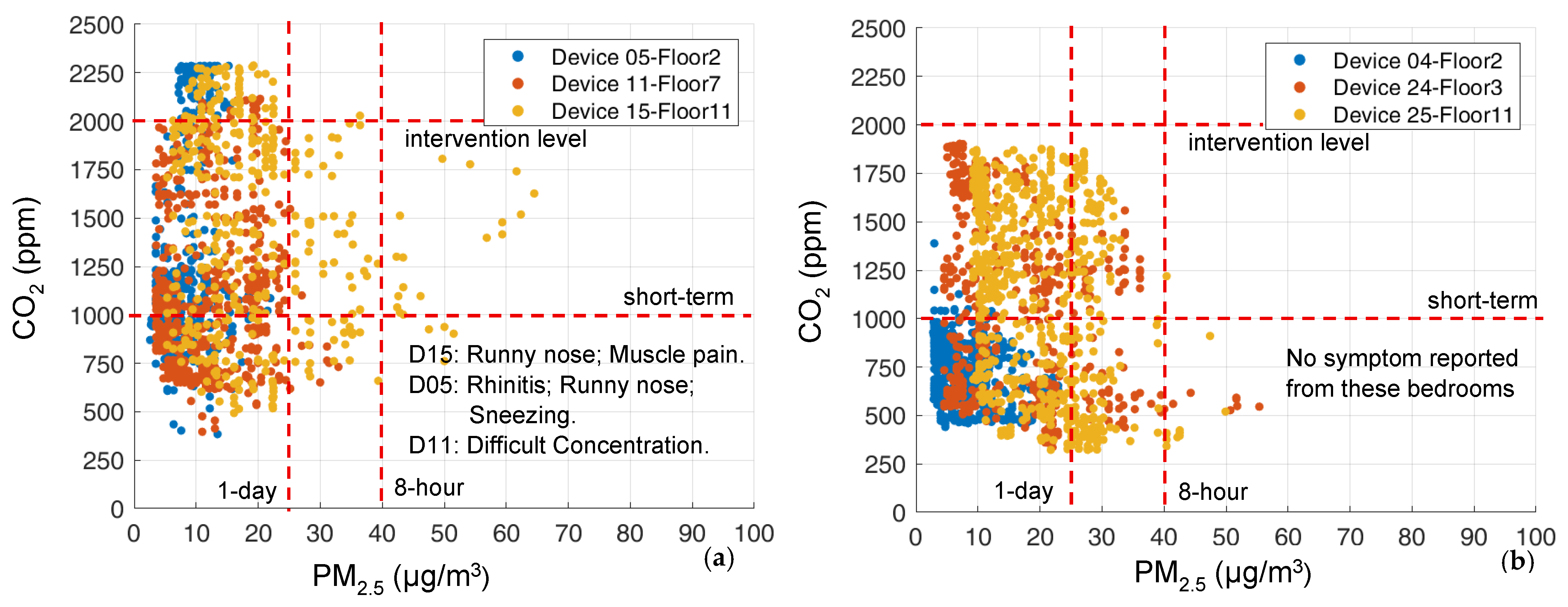
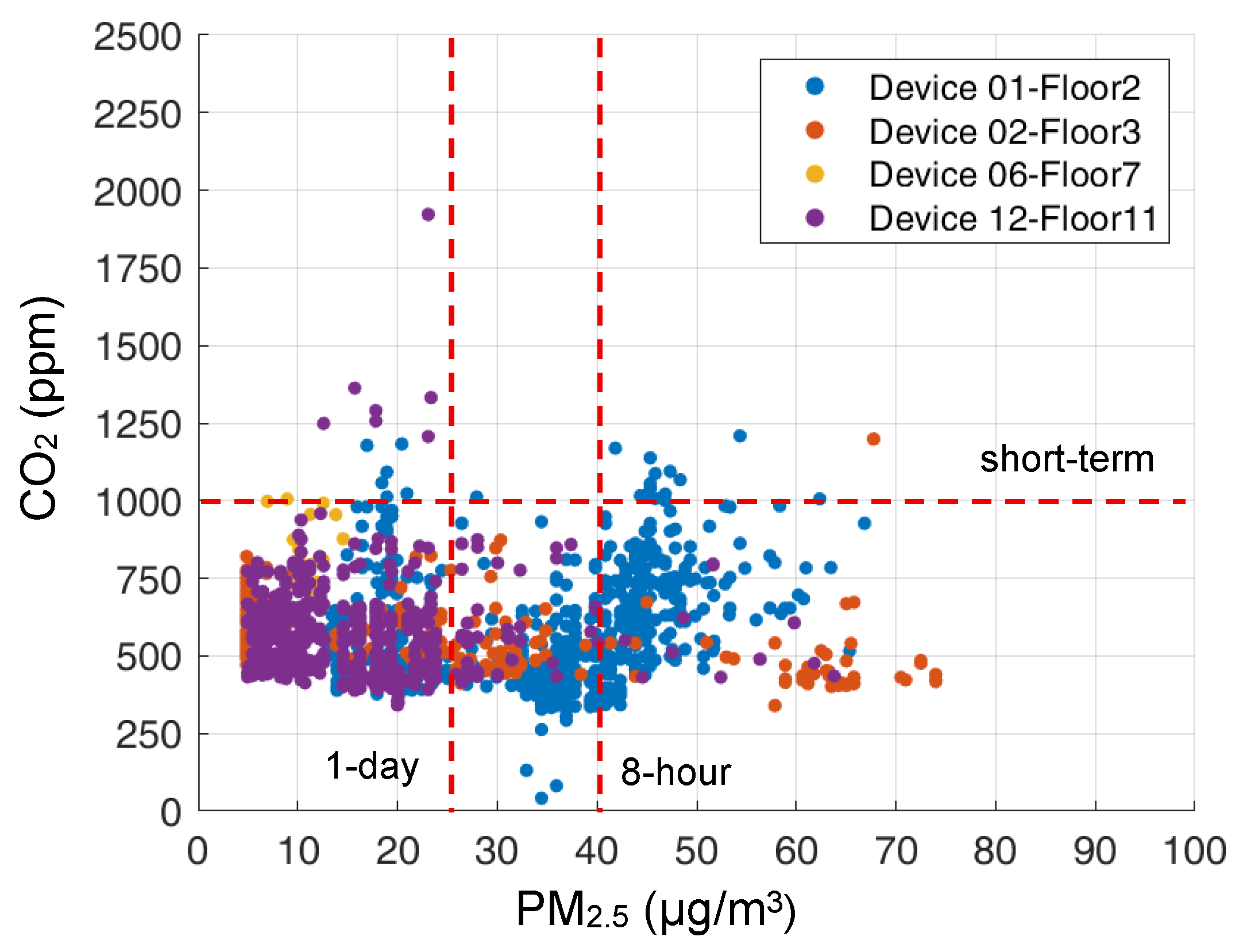

| Type | Ref. | Target | Range | Accuracy | Images | |
|---|---|---|---|---|---|---|
| 1 | SCD41 3 | [21] | CO2 | 400 to 5000 ppm | ±50 ppm + 2.5% |  |
| Temperature | −10 to 60 °C | ±0.8 °C | ||||
| Humidity | 0 to 100% | ±6% | ||||
| 2 | BME680 1 | [22] | Air pressure | 300 to 1100 hPa | ±0.12 hpa |  |
| 3 | PMS 5003T 1,2 | [23] | PM2.5 | 0 to 500 µg/m3 | ±10% |  |
| PM10 | 0 to 500 µg/m3 | ±10% |
| Device Number | Color in Figure 18 | Symptoms Report from Each Unit | ||
|---|---|---|---|---|
| Response-1 | Response-2 | Response-3 | ||
| D01 |  |
|
|
|
| D02 |  |
|
|
|
| D06 |  | No Problem reported |
|
|
| D12 |  | No response from this room | ||
Disclaimer/Publisher’s Note: The statements, opinions and data contained in all publications are solely those of the individual author(s) and contributor(s) and not of MDPI and/or the editor(s). MDPI and/or the editor(s) disclaim responsibility for any injury to people or property resulting from any ideas, methods, instructions or products referred to in the content. |
© 2025 by the authors. Licensee MDPI, Basel, Switzerland. This article is an open access article distributed under the terms and conditions of the Creative Commons Attribution (CC BY) license (https://creativecommons.org/licenses/by/4.0/).
Share and Cite
Yu, Y.; Gola, M.; Settimo, G.; Capolongo, S. Can the Building Make a Difference to User’s Health in Indoor Environments? The Influence of PM2.5 Vertical Distribution on the IAQ of a Student House over Two Periods in Milan in 2024. Atmosphere 2025, 16, 936. https://doi.org/10.3390/atmos16080936
Yu Y, Gola M, Settimo G, Capolongo S. Can the Building Make a Difference to User’s Health in Indoor Environments? The Influence of PM2.5 Vertical Distribution on the IAQ of a Student House over Two Periods in Milan in 2024. Atmosphere. 2025; 16(8):936. https://doi.org/10.3390/atmos16080936
Chicago/Turabian StyleYu, Yong, Marco Gola, Gaetano Settimo, and Stefano Capolongo. 2025. "Can the Building Make a Difference to User’s Health in Indoor Environments? The Influence of PM2.5 Vertical Distribution on the IAQ of a Student House over Two Periods in Milan in 2024" Atmosphere 16, no. 8: 936. https://doi.org/10.3390/atmos16080936
APA StyleYu, Y., Gola, M., Settimo, G., & Capolongo, S. (2025). Can the Building Make a Difference to User’s Health in Indoor Environments? The Influence of PM2.5 Vertical Distribution on the IAQ of a Student House over Two Periods in Milan in 2024. Atmosphere, 16(8), 936. https://doi.org/10.3390/atmos16080936











